#Holly Ordway
Text
Narnia, and the Danger of Becoming an Accidental Christian
"I don't think I ever really feel in danger of accidentally believing... or stumbling into it." Laura Miller
I’m listening to the Unbelievable? podcast replay of the discussion with Holly Ordway & Laura Miller: A convert and skeptic in Narnia. As always, I find the conversation on the Unbelievable! podcast intriguing and thought provoking, as the podcast usually engages people on opposite ends of the thought spectrum.
Holly Ordway and Laura Miller had similar experiences in reading the Chronicles of…
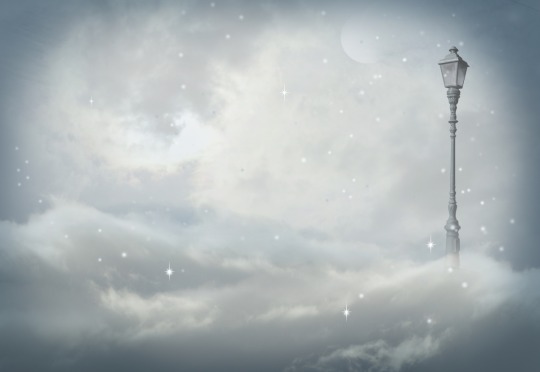
View On WordPress
#atheism#belief in god#Chronicles of Narnia#CS Lewis#Holly Ordway#Laura Miller#Surprised by Joy#Unbelievable!
2 notes
·
View notes
Text
Tolkien's Faith - a Faith & Reason Lecture
Register here
About Holly Ordway
Holly Ordway is the Cardinal Francis George Professor of Faith and Culture at the the Word on Fire Institute and Visiting Professor of Apologetics at Houston Christian University. She holds a PhD in English from the University of Massachusetts Amherst and is a Subject Editor for the Journal of Inklings Studies. Her book Tolkien’s Modern Reading: Middle-earth…

View On WordPress
#Catholic#Catholic Church#Catholic Conscience#Catholicism#Dr Holly Ordway#Faith & Reason#Fides et Ratio#JRR Tolkien#Literature#Lord of the Rings#Middle Earth#St Monica Institute#The Inklings#The Word on Fire Institute#Tolkien#Word on Fire
2 notes
·
View notes
Text
I just started reading the critical review of Tolkien's Faith: A Spiritual Biography (2023), book by Holly Ordway, review by reverend Tom Emanuel, and already in the first page it highlights so so well a huge problem that exists among religious tolkien fans and scholars, where they talk and act like not only they are the true understanders of tolkien because they are religious but they also suppose that their worldview is in fact neutral. that they come to the story from a "neutral" perspective, where neutrality is "truth", where they talk with this self-assured sense of reasonability to posit their unique insight into tolkien, a reasonability that couldn't possibly be stunted by any sort of bias. like the complete inability to note that not only they are biased by their self-identification in tolkien's own faith (disregarding any element of said faith in tension with other aspects of his identity as writer and man, or any element where said faith is amply worth criticising), they are in fact actively partisan and actively self-limiting in the scope of their analysis. this is a problem in scholarship and fandom. the rest of this review sounds promising, it's deeply liberating to see that put into words AND with citations.
24 notes
·
View notes
Text
Christian Apologists are Like Gardeners
I read a brilliant description of Christian Apologetics, and the role of the Christian apologist this week. In her book Apologetics and the Christian Imagination Holly Ordway describes the task of the apologist as that of a gardener.[1] The narrow way of life that Jesus spoke of, involving belief in Christ and assent to his Lordship in our life, can be blocked by rocks, brambles, and overgrowth…

View On WordPress
0 notes
Text
Who are the Spindles anyway? [Part 6]
continued in part 6
Furthermore, Edward is clearly the son of Hollis and Blanche, as evidenced by the 1900 (when two Ellises are living in the household), 1910, and 1920 censuses. [9] The 1910 and 1920 censuses also prove that Ida is the daughter of Hollis and Blanche as well. However, there's still the question of Elizabeth Chalmers, whom apparently was Elizabeth Mortimer but became wife of Kenneth Chalmers. How is she connected? As it turns out, there is an 1940 census entry for a Coloradan man Kenneth Chalmers in Fort Collins City, Larimer, Colorado, married to an Elizabeth. Then there's a 1930 census entry to the same effect, showing them living in Hartsel, Park, Colorado. [10] This is clearly our Elizabeth. That being determined, what is her maiden name and when was she married? Well, we know that Elizabeth's full name is Elizabeth Muriel Mortimer and that she married Kenneth Wadley Chalmers on November 21,1925 in Colorado Springs. We also know that Kenneth, born in 1899, died in 1962 while Elizabeth, born in 1904, died in 1986. We only have one source for Elizabeth prior to marriage listed on Family Search: a 1920 census listing her as the daughter of Stella L. Mortimer. Perhaps this is the Stella Mills whom was said to be Hollis's sister. [11] After all, this census lists her as born in 1881, pretty close to the estimated 1880 I saw on Family Search.
Since her Family Search profile is inadequate, I looked further. The 1930 and 1940 censuses list her as married to an English-born man, John H. Mortimer, who was born in 1871, with the 1910 census also listing Elizabeth as her daughter. [12] However, the 1900 and 1910 censuses say she was born in 1880, while the 1930 and 1940 censuses say she was born in 1881. The 1910 and 1920 censuses lists John's immigration date as 1894. This means he is the individual listed in varied records as born in Cornwall, England. [13] As another clue, the 1900 census shows John and Elizabeth living right next to Edward E. Mills and Edna Russell in Sanborn Precinct, Lincoln County, Colorado:

This census seems to say that Stella and John were married in 1900. But what about the Stella Mills claim? Let's go back to that Family Search profile. Basically the "source" just cites the 1900 census as evidence! This isn't good.
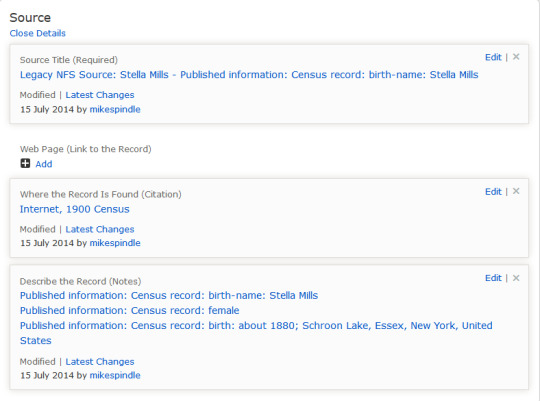
So far, I haven't found anything, even looking in the 1880 census specifically, to support that Stella is the sister of Hollis, and by extension, the daughter of Edward E. and Edna. Perhaps the evidence is out there, but I haven't found it yet. I did find the obituary of Kenneth, who was a Colorado state conservationist, which noted that at his death his wife Elizabeth and his half-sister Belle Wadley were surviving. I couldn't find much in Colorado Historical Newspapers Collection either, unfortunately.
So, this is a good first attempt! Until next time.
This post was originally published on WordPress in February 2019.
© 2019-2023 Burkely Hermann. All rights reserved.
Notes
[9] "United States Census, 1900," database with images, FamilySearch, Edward Mills in household of Hollis Mills, Precincts 3-4, 10-11, 14 Rockt Ford, Olney, Ordway, Hallrook Rocky Ford, Ordway & Sugar City t, Otero, Colorado, United States; citing enumeration district (ED) 81, sheet 57B, family 1130, NARA microfilm publication T623 (Washington, D.C.: National Archives and Records Administration, 1972.); FHL microfilm 1,240,127; "United States Census, 1910," database with images, FamilySearch ( : accessed 20 June 2018), Edward E Mills in household of Hollis R Mills, Precinct 50, El Paso, Colorado, United States; citing enumeration district (ED) ED 23, sheet 11A, family 38, NARA microfilm publication T624 (Washington D.C.: National Archives and Records Administration, 1982), roll 118; FHL microfilm 1,374,131; "United States Census, 1920," database with images, FamilySearch, Edward E Mills in household of Hallis R Mills, Hartsel, Park, Colorado, United States; citing ED 179, sheet 4A, line 15, family 67, NARA microfilm publication T625 (Washington D.C.: National Archives and Records Administration, 1992), roll 168; FHL microfilm 1,820,168.There's also the claim on Edward's Family Search profile that he married a woman named Helen Mildred Robbins and had a child named Edward Ellis Mills, but this seems like an unfounded connection as he was clearly married to Marie S. Mills, otherwise known as Marie Steward as evidenced in the 1940 census, two years after this Edward was born. On the page for this, a family search user writes that "Helen had three sons and later divorced Ray Sanches and left the sons with him, went on to marry and have a son with Edward E. Mills, left him and married many more times after wards never had any more children that we know of. Have since found my father Alberts have brother and his children."
[10] "United States Census, 1940," database with images, FamilySearch, Kenneth Chalmers, Ward C, Fort Collins, Fort Collins City, Larimer, Colorado, United States; citing enumeration district (ED) 35-48, sheet 4A, line 22, family 95, Sixteenth Census of the United States, 1940, NARA digital publication T627. Records of the Bureau of the Census, 1790 - 2007, RG 29. Washington, D.C.: National Archives and Records Administration, 2012, roll 467; "United States Census, 1930," database with images, FamilySearch, Kenneth W Chalmers, Hartsel, Park, Colorado, United States; citing enumeration district (ED) ED 13, sheet 1A, line 24, family 8, NARA microfilm publication T626 (Washington D.C.: National Archives and Records Administration, 2002), roll 248; FHL microfilm 2,339,983; "United States Census, 1900," database with images, FamilySearch, Kenneth W Chalmers in household of Harold Chalmers, Precincts 7-12, 17-18 Lake George, West Four Mile, Freshwater, Martsel, Garo, Salt Works, Howb, Park, Colorado, United States; citing enumeration district (ED) 188, sheet 3B, family 53, NARA microfilm publication T623 (Washington, D.C.: National Archives and Records Administration, 1972.); FHL microfilm 1,240,127; "Colorado Statewide Marriage Index, 1853-2006," database with images, FamilySearch ( : 10 December 2017), Kenneth Wadley Chalmers and Muriel Elizabeth Mortimer, 21 Nov 1925, Colorado Springs, El Paso, Colorado, United States; citing no. 15254, State Archives, Denver; FHL microfilm 1,690,061.
[11] "United States Census, 1920," database with images, FamilySearch, Muriel E Mortimer in household of Stella L Mortimer, Colorado Springs, El Paso, Colorado, United States; citing ED 78, sheet 2A, line 17, family 36, NARA microfilm publication T625 (Washington D.C.: National Archives and Records Administration, 1992), roll 163; FHL microfilm 1,820,163.
[12] "United States Census, 1940," database with images, FamilySearch, Stella L Mortimer in household of John H Mortimer, Colorado Springs, Election Precinct 20, El Paso, Colorado, United States; citing enumeration district (ED) 21-22, sheet 9B, line 41, family 218, Sixteenth Census of the United States, 1940, NARA digital publication T627. Records of the Bureau of the Census, 1790 - 2007, RG 29. Washington, D.C.: National Archives and Records Administration, 2012, roll 461; "United States Census, 1930," database with images, FamilySearch, Stella L Mortimer in household of John H Mortimer, Colorado Springs, El Paso, Colorado, United States; citing enumeration district (ED) ED 20, sheet 7A, line 46, family 164, NARA microfilm publication T626 (Washington D.C.: National Archives and Records Administration, 2002), roll 241; FHL microfilm 2,339,976; "United States Census, 1910," database with images, FamilySearch, Stella Mortimer in household of John H Mortimer, Colorado Springs Ward 3, El Paso, Colorado, United States; citing enumeration district (ED) ED 41, sheet 1A, family 20, NARA microfilm publication T624 (Washington D.C.: National Archives and Records Administration, 1982), roll 119; FHL microfilm 1,374,132; "United States Census, 1900," database with images, FamilySearch, Stella L Mortimer in household of John H Mortimer, Precinct 1-7, 9 Hugo, Arriba, Bovina, Limon, Rush Creek, Sanbom, Urbana, Walks Camp, Lincoln, Colorado, United States; citing enumeration district (ED) 181, sheet 11B, family 189, NARA microfilm publication T623 (Washington, D.C.: National Archives and Records Administration, 1972.); FHL microfilm 1,240,126.
[13] "England and Wales Census, 1891," database with images, FamilySearch, John H Mortimer in household of Frank James, Ledbury, Herefordshire, England; from "1891 England, Scotland and Wales census," database and images, findmypast (http://www.findmypast.com : n.d.); citing PRO RG 12, Herefordshire county, subdistrict, The National Archives of the UK, Kew, Surrey; "England and Wales Census, 1881," database with images, FamilySearch, John H Mortimer in household of John Mortimer, Easington, Yorkshire,Yorkshire North Riding, England; from "1881 England, Scotland and Wales Census," database and images, findmypast (http://www.findmypast.com : n.d.); citing p. 9, Piece/Folio 4839/38, The National Archives, Kew, Surrey; FHL microfilm 101,775,347.
#mills#chalmers#mills family#chalmers family#family history#ancestry#genealogy#1900#1910#1880#1881#1920#census#1871#mysteries#wordpress#20th century#19th century
0 notes
Text
Duchowa biografia Tolkiena
Nowa książka Holly Ordway, zatytułowana Tolkien's Faith: A Spiritual Biography, ukaże się we wrześniu. Opisywać będzie życie Tolkiena od strony jego wiary, jej rozwoju i wpływu na jego twórczość.
Nowa książka Holly Ordway, zatytułowana Tolkien’s Faith: A Spiritual Biography, ukaże się we wrześniu. Opisywać będzie życie Tolkiena od strony jego wiary, jej rozwoju i wpływu na jego twórczość.
Continue reading Untitled
View On WordPress
0 notes
Text
EN BUSCA DE LA BELLEZA by Jaime Nubiola
EN BUSCA DE LA BELLEZA by Jaime Nubiola
La semana pasada estuve en Madrid y pude reunirme un rato con mi buen amigo Juan Pablo Serra, profesor de la Universidad Francisco de Vitoria. En nuestro breve encuentro, Juan Pablo me regaló un ejemplar del libro de Holly Ordway «Dios no va conmigo», publicado por la propia Universidad. Me dijo al entregármelo: “Te gustará”. Aproveché el viaje de vuelta para leerlo y lo he terminado en mis…

View On WordPress
0 notes
Link
“The word sin has particular meaning for a Christian. We understand what it means. We know theologically what it means. We know experientially what it means. But that meaning is not particularly accessible to the average non-Christian. So for me as a non-Christian not believing in God, my understanding of what the word sin meant was totally different. It was really a list of things that some religious people say are bad to do because a god that I don’t believe exists said so. It wasn’t a category that had any bearing on my life.
But, I did have a recognition that the world wasn’t working the way it ought to, and that “ought” is part of the whole thing that brought me to believe in God. Because why did I have a sense of “ought” in the first place? That was the nose of the camel so to speak, the thin end of the wedge. But I had an awareness — what I articulated as that the world was a broken place. It wasn’t working the way it should, and I myself was also broken in the sense that I could imagine myself being much better than I was actually capable of being. I didn’t know that that’s what Christians understand as sin, because the words weren’t connected to me.”
This article is a good read, I really liked at the beginning where she touches on the “meaning gap,” where when we as Christians say things like ‘sin,’ ‘heaven,’ ‘God,’ we often assume a particular meaning, but that meaning is not actually what people are understanding. We need to understand for ourselves the terms we are using, and then impart the meaning of these terms in our conversations with other people. Otherwise, when we say ‘God,’ people will think we mean ‘old man in the clouds that shoots thunderbolts’ or some vague notion of overall goodness, when we actually mean something completely different.
9 notes
·
View notes
Photo

"People need to see that the faith is meaningful, for them to care whether it's true or not. So, our whole lives need to be examples of how it's meaningful. And so, to take just one example, say you invite your atheist friend to come to Mass with you. And because you've been a good friend and because you haven't been pushy, he says, 'Okay, I'll come with you.' Now, when he comes to Mass, what's he going to see? He's going to see a lot things he doesn't understand. Okay, that's fine. He doesn't have to. But he needs to see that this is meaningful. And how is he going to see that? Primarily through the way that people behave. You know, the kneeling and prayer, the reverence, the attention. That is going to show him, 'Hey, there's something going on here that's real. I do not understand it, I don't know anything about it, but it's meaningful. Maybe I'll ask my friend a question, you know, after Mass when we're hanging out and having pizza together.' Right? But we have to see that. So even the smallest things that show the meaning of our faith can really have a tremendous impact on people like I once was, and our neighbors who don't yet believe." -Dr. Holly Ordway
(picture source: http://2-timothy.blogspot.com/2012/11/the-moon-reflects-son.html)
13 notes
·
View notes
Text
«When we attempt to share our faith with someone, and we don’t attend to the way we use words like “salvation,” “incarnation,” or even “Holy Spirit,” we may end up being about as comprehensible as if we’d started speaking in Elizabethan English [...]
«As we consider the analogy with Shakespearean language, the approach of translation may come to mind. Although the Christian terms that we need to imbue with meaning are already in modern English, “translating” them into different words and phrases could help people grasp the ideas. This seems logical...perhaps even too simple. Are we missing anything? Perhaps we should consider whether it works to translate Shakespeare? [...]
«The anti-translating-Shakespeare argument has three main points—and all three of them have parallels in Christian apologetics [...] But translation doesn’t necessarily mean oversimplification. If it does oversimplify, it’s a bad translation. (Hello, “No Fear Shakespeare,” which I banned from my undergrad classes.) If translation per se were bad, we could not read any work written in a foreign language without learning the language...»
— Holly Ordway: Translating Shakespeare: or, How to Evangelize and Not Be Eaten by a Bear
1 note
·
View note
Text
Trends in Apologetics: Cultural Apologetics
Trends in Apologetics: Cultural Apologetics

This is the second part of a series I am doing in Trends in Apologetics. I have covered Urban Apologetics and will look at Women in Apologetics, and Children’s Apologetic in future posts.
Cultural Apologetics
What is Cultural Apologetics? Answering this can be a little tricky. So, given that this tricky I will let someone else answer the question: Holly Ordway. Dr. Ordway is the professor of…
View On WordPress
#c. s. lewis#charles williams#cultural apologetics#dorothy sayer#g. k. chesterton#holly ordway#imaginative apologetics#j. r. r. tolkien#literary apologetics#louis markos#michael ward#urban apologetics
0 notes
Text
ATEOS QUE HAN CAMBIADO DE OPINION
1- INTRODUCCION
El ateísmo para que sea cierto requiere que el universo natural sea todo lo que exista (eso excluye lo sobrenatural) hay dos opciones de un universo natural el cual favorece a un ateo, como señalo el filósofo agnóstico Spencer las opciones son: "el Universo es eterno o el universo se creó a sí mismo, no hay otras opciones" (Herbert Spencer, 1882)
Gracias a la ciencia moderna sabemos que el universo no es eterno, Robert Jastrow astrónomo ex
director del Instituto Goddard para Estudios Espaciales en la NASA, escribió:
"Ahora, tres líneas de evidencia (los movimientos de las galaxias, las leyes de la
termodinámica, la historia de vida de las estrellas) apuntan a una conclusión; todos indicaron
que el Universo tuvo un comienzo" (Jastrow, Robert 1978 p 111)
Por la termodinámica, ecuaciones basadas en la relatividad general y demás líneas de evidencias científicas se llega al punto de concluir que el universo es finito con un inicio absoluto indiscutible, el astrofísico Paul davies señalo:
"El universo no puede haber existido para siempre. Sabemos que debe haber habido un comienzo
absoluto hace un tiempo finito" (Paul Davies “The Big Bang—And Before,” 2002)
si el universo tuvo un inicio significa que no es eterno, se puede sugerir entonces que el universo se creó el mismo pero eso es absurdo, eso implica que lo no-existete creó su propia existencia antes de existir lo cual es ilogico e imposible
como podemos ver, un universo eterno es falso y un universo que se crea así mismo es imposible, si el universo tuvo un inicio debe existir una causa que lo trajo a la existencia, la cadena de causas no puede ir hacia atrás en regresión infinita ya que da lo mismo a que no hubiera inicio (ver Leibniz) por lo tanto debe existir una causa eterna (ver Locke)
Debe existir una causa eterna que creo nuestro universo finito y esa causa creadora es lo que
todos llaman: Dios
Para ser ateos debes de negar esos hechos y eso precisamente es lo que hacen los ateos, pero han existido ateos sabios que como dijo el filosofo Kant "cambiaron de opinión"
2- EX ATEOS
A- C.S. LEWIS:
C.S. Lewis fue un filósofo, el impartio clases en la universidad de Oxford, el desde los 15 años fue un ateo, años despues influenciado por compañeros de Oxford exploro los argumentos para Dios y el cristianismo y eso dio paso a su conversión, él es conocido por su famoso libro "Mero cristianismo"
https://es.slideshare.net/rubysaez/cristianismo-y-nada-ms-por-cs-lewis
B- Douglas DEWAR:
Douglas Dewar fue un británico que estudio ciencias naturales en Cambridge, el se convirtió en un ornitólogo (especialista en estudios de las aves) el era un evolucionista y escribió muchos artículos y libros sobre aves, debido al analisis a la evolucion el se percato de la falsedad de esta, él abandono el evolucionismo y luego el ateismo, acepto el cristianismo y se convirtió en un ferreo anti-evolucionista y escribió un libro titulado "Dificultades de la teoría de la evolución"
https://www.amazon.co.uk/DIFFICULTIES-EVOLUTION-THEORY-Douglas-Dewar/dp/B005G04PQO
B- JOSH MCDOWELL:
Josh McDowell es un americano que en su juventud fue parte de la Guardia Nacional Aérea, inicio sus estudios jurídicos con la intención de ser político, mientras estaba en la universidad comenzó un estudio para desmentir el cristianismo pero en su investigación encontró datos que mas respaldaban al cristianismo, el ser convirtió en cristiano y se graduó como teólogo en la universidad de Biola y desde entonces se ha dedicado a la defensa de la fe, él es conocido por su obra "Evidencia que exige un veredicto"
dos excelentes películas acerca de su vida y la defensa de la fe se pueden ver:
Aqui: https://www.youtube.com/watch?v=4tJzpveFsPI
Aqui: https://www.youtube.com/watch?v=P9Jki-srsJ8
C- Rosaria Butterfield:
Butterfield tiene un doctorado filosófico en literatura inglesa por la universidad de Ohio, ella se desempeñó en el Departamento de Inglés y el Programa de Estudios sobre la Mujer en la Universidad de Syracuse
Butterfield era una lesbiana y atea pero se convirtió al cristianismo y escribió el libro "Los
pensamientos secretos de un converso poco probable: El viaje de un profesor de inglés hacia la
fe Cristiana"
https://www.amazon.com/Secret-Thoughts-Unlikely-Convert-Professors/dp/1610458206
D- Joshua Rasmussen:
Josh Rasmussen es un filósofo profesional americano, él es profesor de Filosofía que se especializa en metafísica analítica con un enfoque en categorías básicas de la realidad, tales como objetos, ideas y existencia necesaria etc.
El era un ateo pero se convirtió en cristiano, su libro acerca de cómo podemos por la razón llegar a comprobar la existencia de Dios se titula "El Puente de la Razón: Diez pasos para ver a Dios"
https://www.amazon.com/Bridge-Reason-Ten-Steps-See/dp/173238343X
E- Martin Jobe:
Jobe es un americano que estudió biología en la Universidad de Bucknell, tambien se graduo de odontología de la Universidad de Pittsburgh, él era un evolucionista pero mientras impartía clases en Baylor College comenzó a cuestionar la evolución y con el paso del tiempo se convirtió en cristiano, el escribió el libro titulado "La evolución de un creacionista" el libro puede descargarse aqui:
http://www.evolutionofacreationist.com/files/TheEvolutionofaCreationist.pdf
F- Dra. HOLLY ORDWAY:
Holly Ordway es una americana que obtuvo un doctorado en literatura de la Universidad de Massachusetts, ella era una atea que creía que Dios era una superstición, completamente sin el apoyo de la evidencia o la razón
Ella noto que muchos grandes de la literatura habían sido personas de fe, luego se expuso a la apologética cristiana y fue así como noto los argumentos racionales para creer en Dios y la evidencia para el cristianismo, ella escribió el libro "No es el tipo de Dios: un académico ateo baja los brazos"
https://www.amazon.es/Not-Gods-Type-Atheist-Academic-ebook/dp/B00OIBA3QI
G- Sarah Salviander:
Sarah Salviander estudio física en Eastern Oregon University, luego se unió al grupo del Centro de Astrofísica y Ciencias del Espacio (CASS) y más tarde se graduó en astrofísica en la Universidad de Texas
Ella primero se convirtió en teísta (acepto la existencia de un creador) y más tarde se convirtió en cristiana, para ver más acerca de su historia leer:
https://www.acontecercristiano.net/2015/08/cientifica-atea-se-convierte-cristo.html
H- Lee Strobel:
Lee Strobel fue editor legal de Chicago Tribune, él era un ateo que se dedicó a investigar el cristianismo y por la evidencia termino aceptando la veracidad de este y termino por convertirse en cristiano
Lee Strobel a escrito numerosos libros en defensa de la fe, aquí se puede ver su documental titulado el caso del creador:
https://www.youtube.com/watch?v=dSr8h937xXE
I- Edward Feser:
Edward Feser es un filósofo americano que obtuvo su doctorado en la Universidad de California, él fue un ateo desde su juventud hasta que estudio a profundidad los argumentos filosóficos para la existencia de Dios, el escribió el magnífico libro "Cinco pruebas de la existencia de Dios"
https://www.amazon.com/Five-Proofs-Existence-Edward-Feser/dp/1621641333
3- CONCLUSION
Iba a seguir con la lista ya que existen muchos químicos, biólogos, filósofos etc que han abandonado el ateísmo y se han convertido al cristianismo pero tengo perea y por el momento dejare esto aquí
El ateísmo es falso filosóficamente como lo señalo el filósofo Henry More en su obra "antidoto contra el ateismo" el ateísmo por su falsedad es algo odioso como señalo el filósofo Francis Bacon padre del método científico, el ateismo es insensato y por ende odioso a la humanidad como lo dijo Newton
El ateísmo es una falsedad, pero muchos ateos sabios han cambiado de opinión y se han convertido en cristianos

#frases#evangelio#christ#truth#cristo#diosesfiel#jesucristo#faith#devocional#scripture#prayer#dios#escritos
41 notes
·
View notes
Text
DC’s Nuclear Winter Special (Comic Book Review)
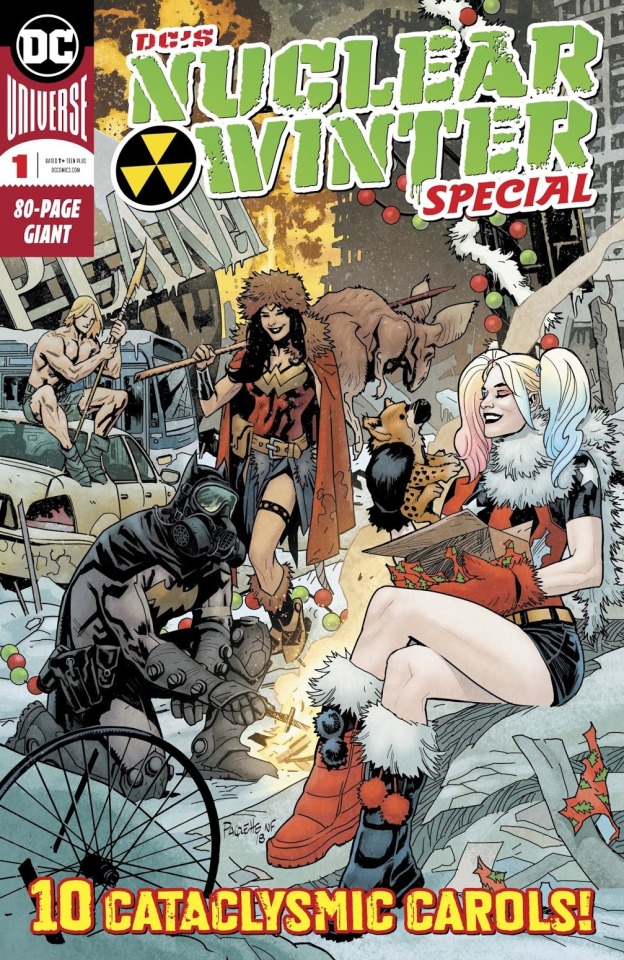
There are plenty of reasons to not feel like getting into the holiday spirit, many of them valid and more apparent in the world at large this year in particular. So in the spirit of a time where it can feel like the world is ending, I’m going to recommend DC Comics’ 80-page holiday anthology special for this year, the Nuclear Winter Special. Featuring ten different stories focusing on some of the DC Universe’s greatest heroes from across time dealing with struggles in varied post-apocalyptic environments and connected to the holiday season in some way.
The ten stories and creators are the following:
Rip Hunter (writer: Mark Russell, art: Mike Norton, colors: Hi-Fi, letters: Daron Bennett)
Batman 666 (writers: Collin Kelly & Jackson Lanzing, pencils: Giuseppe Camuncoli, inks: Cam Smith, colors: Romulo Fajardo Jr., letters: Clayton Cowles)
Superman One Million (writer: Steve Orlando, pencils: Brad Walker, inks: Drew Hennesy, colors: Nathan Fairbairn, letters: Clayton Cowles)
The Flash (writer: Jeff Loveness, art: Christian Duce, colors: Luis Guerrero, letters: Tom Napolitano)
Supergirl (writer: Tom Taylor, breakdowns: Tom Derenick, art/colors: Yasmine Putri, letters: Deron Bennett)
Aquaman (writer: Mairghread Scot, art: Dexter Soy, colors: Veronica Gandini, letters: Steve Wands)
Firestorm (writer: Paul Dini, art: Jerry Ordway, colors: Dave McCaig, letters: Dave Sharpe)
Kamandi (writer/pencils: Phil Hester, inks: Ande Parks, colors: Trish Mulvihill, letters: Steve Wands)
Catwoman (writer: Cecil Castelucci, art: Amancay Nahuelpan, colors: Brian Buccellato, letters: Josh Reed)
Green Arrow (writer: Dave Wielgosz, art: Scott Kolins, colors: John Kalisz, letters: Alex Antone)
[Full Review Under the Cut]
I’ll mostly be going out of order for how I discuss the stories in this anthology special. However, the first two in the book are worth grouping together for discussion, the Batman 666 and Superman One Million stories. Both expansions on characters from alternate futures presented during Grant Morrison’s runs on Batman and JLA, respectively.
The story of Damian Wayne as the future Batman wandering the frozen wasteland while pondering if his dedication to his father’s ideals still means anything in the remains of the world, when he’s one of the people who ruined it. Multiple stories in this special play on the idea that time stopped really meaning anything in the post-apocalyptic landscapes the characters are left in, so they’re made to focus more on the essence of what the holidays represent. Kelly, Lanzing, Camuncoli and Smith bring in the idea of family togetherness by introducing Damian’s grandfather, Ra’s Al Ghul, into the story with the way the fight between the Bat and the Demon resolves coming down to the end of the world helping Damian put where his values are in perspective.
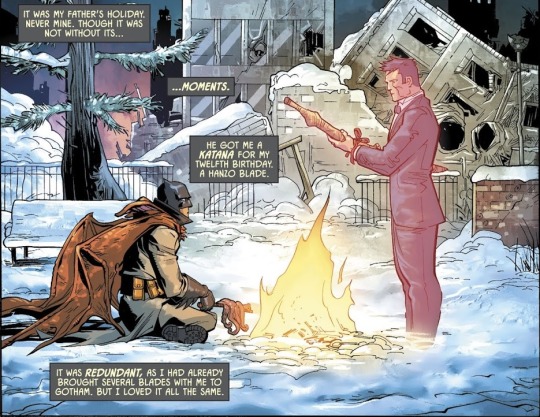
Superman One Million’s story focuses on togetherness as well, but from another perspective and adding in the idea of the importance of memory. While Kal Kent, the Superman of the 853rd century, is highlighted in the table of contents for this issue, his segment of this issue absolutely belongs more to J’onn J’onzz, the Martian Manhunter. If this issue indicates Orlando’s approach to writing J’onn, then his upcoming miniseries focusing on the character is going to be something special. How canon anything in this special is meant to be taken loosely at best, but I like what this short story adds to J’onn’s character history when Kal Kent goes back in time to stop a time travelling villain from destroying the Superman Dynasty before it starts. The sequence where Kal gives J’onn back the memories of their past encounter the were removed for the sake of preventing paradoxes among the most heartwarming moments in a book full of them.
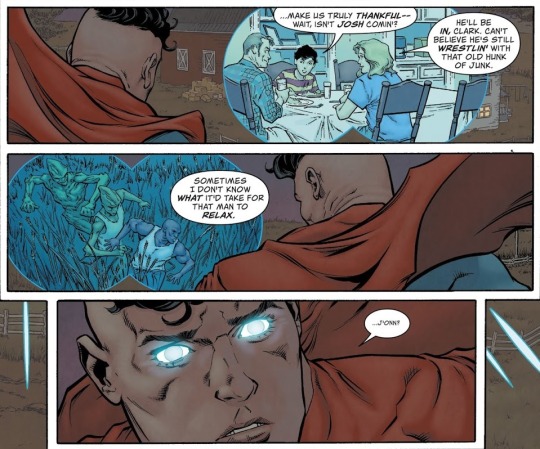
On the topic of stories that add interesting new details to the featured character’s background, the Kamandi story by Phil Hester does this by way of tribute to the character’s creator, Jack Kirby. It takes the already heightened world that Kamandi inhabits and places this adventure within a framework that calls back to the stories of both Hanukkah and the Nativity. The Hanukkah elements are mostly in play as something Kamandi recalls from his time growing up in a bunker with his grandfather telling him stories. As far as I know, this is the first story in the character’s history to feature the idea that Kamandi is of Jewish decent. In addition to that neat detail, there are ways that this story feels more complete than a couple of the others within this issue as it manages to set up all its necessary elements quickly and executes paying them off in a satisfactory manner within the limited page count.
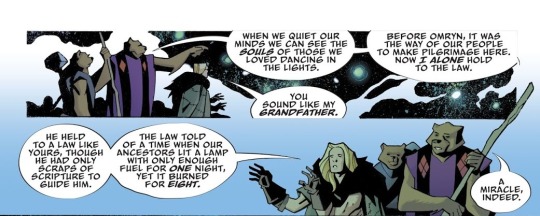
Another story that makes effective use of its short page count is the Firestorm story, “Last Christmas.” The brief tale of Ronnie Raymond and Professor Stein having a final confrontation with the android Nuclear Family as they face their last Christmas ends up weirdly poignant and heartwarming. Dini and Ordway work together to balance the tragedy of the supervillain family with them still being a genuine threat. That tragedy also reflects on the kindness of Ronnie and Stein as they figure out how to save the day while letting the Nuclear Family’s final Christmas be a merry one in the end.

Two more stories that contain some interesting parallel structures are the Catwoman and Supergirl stories. Each one puts the focus heroine in a parental role and shows how that keeps them inspired to action, even in the face of a world that’s falling apart. Catwoman’s story starts with Selina in a position where she mainly seems to be using her role as guardian to the daughter of her longtime friend, Holly Robinson, as a reason to remain self-interested in the dystopian Gotham. In a time when people are forced to stretch whatever resources they manage to get their hands on for as long as possible, Selina debates her charge about whether they should try to help others when their own supplies keep running low. Eventually, Selina gives into her better nature and it inspired to play the role of Santa Claus by way of Robin Hood.
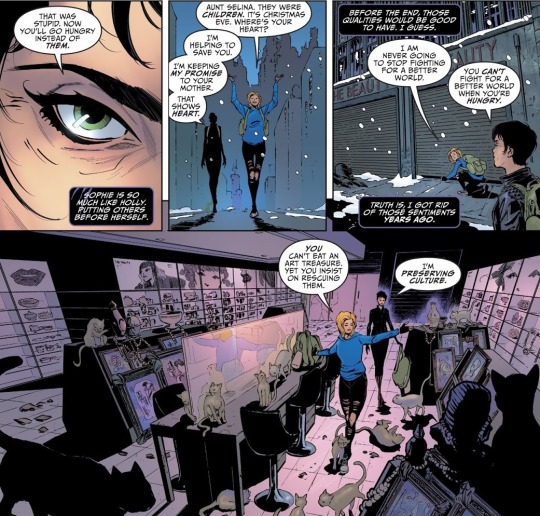
Writer Tom Taylor went to Twitter to ask people not to read the table of contents of this anthology, so they wouldn’t spoil his Supergirl story for themselves with its title. Since this easily makes the strongest contender for best story in the book, I’ll oblige by not giving away the ending either. The older Kara Zor El in this story looking after her adopted daughter in the “Not Distant Enough Future” journeying across the blighted Earth to find some place she can charge up her powers again is a compelling start to the story. The ending of the story builds up to Kara reflecting on a simple idea. In the face of the end, she has a choice to either perpetuate the cycles started by those who came before her or do something better. If you know anything about the Super-family, what her final choice ends up being won’t come as a surprise.
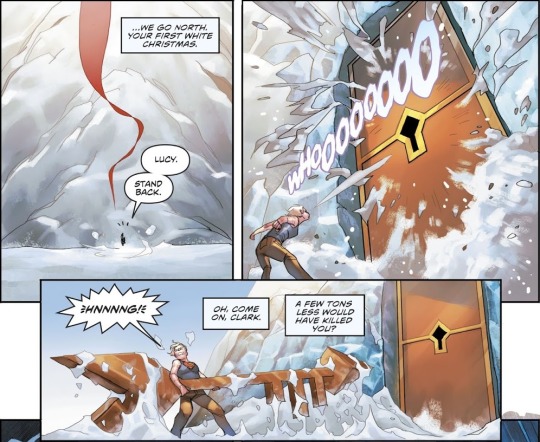
While I don’t think any of the stories in this special are bad, there were three I felt fell short of the standards of most of this issue. The Flash and Aquaman stories, while playing on the same themes of hope in the face of a hopeless existence that permeate the rest of this issue, are the ones that stretch the holiday connection the most. Though both still serve as pretty good highlights for their focus heroes. The choice of focus hero was my main issue with the Green Arrow story. I’ve never particularly liked or disliked Oliver Queen as a character, but this story seems to require some type of investment in him to get something out of him being grumpy at a future Justice League’s Christmas party. Though the actual weakest part of the book is the framing device with Rip Hunter, which doesn’t seem to serve much purpose related to the other stories beyond being a framing device.
DC’s Nuclear Winter Special showcases the present creators pulling some great material for the featured heroes within the setup of the titular motif. There are certainly people reading this who will get more out of the stories I was dismissive towards and the average quality of the ones I’ve highlighted is strong enough to give this 80-page special a strong recommendation as a way to get into the holiday spirit with some exemplary superhero storytelling.

If you like what you’ve read here, please consider throwing some support my way at either Patreon or Ko-Fi at the extension “/witswriting”
#DC Nuclear Winter Special#Wit's Writing#Comic Book Review#Christmas#Christmas comics#comic books#comics
15 notes
·
View notes
Link
Great interview. Great perspective on Tolkien’s relationship with modern authors, the Chronicles of Narnia, and Tolkien’s modern influences.
0 notes
Text
"Tolkien’s Modern Reading" – o Tolkienie czytającym współczesnych autorów
“Tolkien’s Modern Reading” – o Tolkienie czytającym współczesnych autorów
Nowa książka o Tolkienie, podejmująca dyskusję z poglądem, według którego Profesor nie wykazywał żadnego zainteresowania współczesną literaturą, ukaże się w przyszłym tygodniu. Autorką Tolkien’s Modern Reading jest Holly Ordway.
Continue reading

View On WordPress
0 notes
Text
Trends in Apologetics: Women in Apologetics
Trends in Apologetics: Women in Apologetics
This is the third part of a series I am doing on Trends in Apologetics. I have covered Urban Apologetics and Cultural Apologetics and will look at Children’s Apologetic in a future post.
Women in Apologetics
Given the proliferation of men in apologetics, the questions that begs to be answered is “are women interested in apologetics?”
The short answer is yes. An example is the International…
View On WordPress
#amy orr-ewing#apologetic trends#apologetics for women#holly ordway#lydia mcgrew#mary jo sharp#melissa travis#nancy pearcey#trends in apologetics#women in apologetics
0 notes